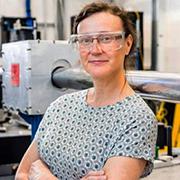2022
Argonne’s Aurora supercomputer and upgraded Advanced Photon Source will be powerful tools for discovery. Together, they’ll form a scientific super merger: The combined data collection and computing power will advance discovery time and unlock new science.
As a safety systems interlocks engineer, Anne Boron oversees the safety of researchers at the Advanced Photon Source.
Xuanyi Zhang of North Carolina State University is the first-place winner of the 2022 APL Materials Excellence in Research Award competition for a paper based on research at the Advanced Photon Source.
Assembling the new storage ring for the Advanced Photon Source is like putting a puzzle together.
Looking for a role that could let her creativity and innovation shine, Maria O’Neill joined the U.S. Department of Energy’s Argonne National Laboratory as a mechanical designer in 2013. Now she's designing vacuum-related components for the major upgrade of the Advanced Photon Source at Argonne.
When the IDEA beamline was built and put into operation at the Advanced Photon Source in early 2020, a small team of scientists recognized a unique opportunity to evaluate the beam itself, as well as conduct other high-impact research.
University of California, Santa Cruz Professor Dongwook Lee has won a three-year, $1.1 million grant from the U.S. Department of Energy, which will fund his research on improving computer models for safety mechanisms within particle accelerators. For this project, Lee will collaborate with scientists at the Advanced Photon Source at Argonne National Laboratory.
Nena Moonier to Represent APS at the Leadership Academy for Women in Science and Engineering Program
Nena Moonier, Experimental Facilities Operations Group Leader in the Advanced Photon Source Engineering Support Division, has been selected as a participant in the inaugural Leadership Academy for Women in Science and Engineering (LAWISE) program.
Advanced Photon Source user Timothy A. Springer (Boston Children’s Hospital/Harvard Medical School) is one of three recipients of the 2022 Albert Lasker Basic Medical Research Award for discoveries concerning the integrins—key mediators of cell-matrix and cell-cell adhesion in physiology and disease.
The upgrade of the Advanced Photon Source is under way. And there’s no surer sign of that than construction actually happening at the facility. The project’s feature beamlines are starting to take shape, and the latest to begin its transformation is located at Sector 8.
Research into the monkeypox virus is in its early stages at the Advanced Photon Source, but studies on other pox viruses may offer some insight into this family of diseases, insight that might help in the fight against the current outbreak.
For more than 25 years, scientists hoping to make use of cutting-edge technology for x-ray spectroscopy have come to Sector 20 of the APS. Now the 20-ID beamline is transforming into the High Energy X-ray Microscope, one of the feature beamlines under construction as part of the APS Upgrade Project. The spectroscopy program will move to a new beamline, 25-ID, which will offer enhanced and improved scientific tools for users.
There’s something challenging and inspiring about following up a perfect 25-plus-year record. Just ask John Zientek, a vacuum engineering specialist working on the new vacuum system for the upgrade of the Advanced Photon Source.
A year ago, scientists got their first look at material gathered from nearby asteroid 162173 Ryugu. Now the results of those studies, including those at the APS, have been revealed, and they shed light on the history of our solar system and the long trek of this cosmic wanderer.
A group of control system developers from NASA’s Glenn Research Center Armstrong Test Facility visited the Advanced Photon Source on September 9, 2022. The purpose of this field trip was to see a live demonstration of the Experimental Physics and Industrial Control System (EPICS).
Researchers have enlisted the U.S. Department of Energy’s Advanced Photon Source to answer the question: When is a book not a book? What they find might end up rewriting a chapter of modern art history and might shine new light on one of the pioneers of an artistic movement.
Two members of the Advanced Photon Source Engineering Support Division and a member of the Infrastructure Services Division who is assigned to the APS are among the Argonne employees throughout the Lab who received Argonne National Laboratory Board of Governors Awards for Outstanding Safety Performance.
As part of an upgrade to the Advanced Photon Source, scientists studying the “chemical map” of samples will have better proximity to colleagues, improved research tools and state-of-the-art facilities.
The U.S. Department of Energy’s Advanced Materials for Energy-Water Systems Center has been renewed for another four years and will continue providing pivotal discoveries related to advanced materials underpinning future solutions to water crises. Planned experiments could be among the first to leverage the new capabilities available when the upgrade of the Advanced Photon Source comes online.
Polaris, the newest supercomputer at the U.S. Department of Energy’s Argonne National Laboratory, is now open to the research community. It will be a key tool for integrating Argonne Leadership Computing Facility computing resources more closely with DOE experimental facilities such as the Advanced Photon Source and Center for Nanoscale Materials.




















